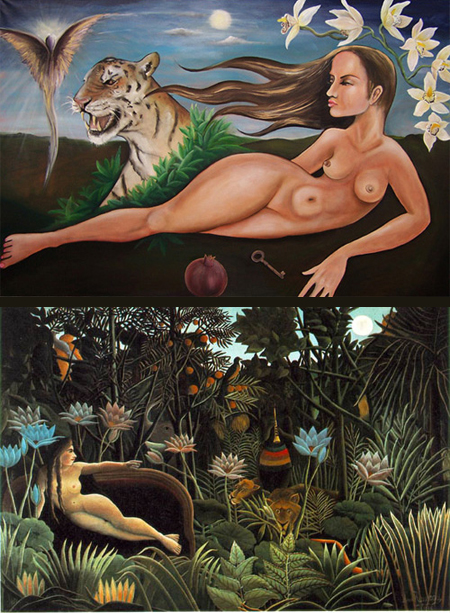Germany is celebrating Paula Modersohn-Becker (1876-1907), an important representative of early expressionism, on the 100th anniversary of her death. From 1906 to 1907, she painted nude self-portraits, at that time an unprecedented opus by a female painter.
Her work inspired me to compare female nudity seen through her eyes in 1906/07 to those painted by males between 1918 and 1570 – Modigliani, Gauguin, Renoir and Tintoretto.

I. Amedeo Clemente Modigliani (1918) Paula Modersohn-Becker (1906)

II. Eugene Henri Paul Gauguin (1891/94) and Paula Modersohn-Becker (1906)

III. Tintoretto (1570) and Paula Modersohn Becker (1906)

IV. Pierre-Auguste Renoir (1875) and Paula Modersohn Becker (1907)
In response to the first comment, I am adding two pictures:
Angela Ferreira – ‘Punica Malum’ 2007 and
Henri Rousseau – ‘The Dream’ 1910

Any further comments?

http://sunsite.utk.edu/FINS/Cyberspace_Capital/RousseauDream.jpg
Henri Rousseau – ‘The Dream’ 1910
http://amadeo.blog.com/repository/98271/2568080.jpg
Angela Ferreira – ‘Punica Malum’ 2007
Angela,
Thank you for suggesting the fitting addition, a comparison of nudes and lions from female and male perspectives, separated by almost a whole century.
Birgit,
Did you happen to find who did the earliest male nude self-portraits? Surely someone of note was bold enough?
I’m especially curious about the first and third by Modersohn-Becker, which are nearly identical in pose and background. Are they from a series of variations?
Steve:
The things you come up with…
There was that Coplans fellow who did a photographic series of himself naked and seventy. But that wasn’t that long ago. Thomas Eakins – just remembered. That would at least take things into the nineteenth century.
Steve,
There is another ‘first’ associated with Paula M-B: From http://www.pmbm.de/
Paula M-B’s painting in III is entitled: Selbstbildnis als Halbakt mit Bernsteinkette II. Thus, I assume that the paintings in I and III are part of a series.
I only recently became interested in Paula M-B. At a German high school during the middle of 19th century, my attention had been directed towards Kaethe Kollwitz.
Hopefully, the Bremen Museum will be open over the winter holidays so that I can see Paula M-B’s original work. Bremen is only about 75 miles from my German hometown.
I am also fascinated by Paula M-B’s friendship with Rainer Maria Rilke. Somewhere I read, that Rilke’s poetry improved after his shock about her untimely death. I hope that next year, I will know more about Paula M-B’s paintings and Rilke’s poetry.
Steve,
The title is a spoof of science writing. ‘This is the FIRST reported instance of a honeybee copulating with a spider’.
Having made a living by competing in a world run by men, I am becoming increasingly interested in female expressions and the overlap between the spectra of female and male characteristics.
None of the women painted by men look as happy as the ones by M-B.
Steve,
Looking at M-B, the word lyric comes to my mind.
Angela introduced another type of expression that I saw in more contemporary female nudes painted by female artists – self-possession.
I thought exactly the same about Angela’s, but the Rousseau is not so different that way.
Yes, the lady in the Rousseau looks pretty determined.
Ah, but the tiger is coming after the Rousseau femme, whereas Angela’s tiger is one with her woman. Self-posession, indeed, to be accompanied by a tiger!
I had forgotten paula M-B’s work and never knew of her relationship with Rilke. I was just reading a Rilke poem today from The Writer’s Almanac (Garrison Keillor’s daily addition to the world):
One princess let him [Rilke]live for a while in her Castle Duino near Trieste, a medieval castle with fortified walls and an ancient square tower. Rilke’s room had a view of the gulf of Trieste, which he loved. In a letter from his room he wrote, “I am looking out into the empty sea-space, directly into the universe, you might say.”
It was that winter of 1912, alone in the castle, that Rilke later said he heard the voice of an angel speaking to him about the meaning of life and death, and he started a poem that began with the lines, “And if I cried, who’d listen to me in those angelic / orders? Even if one of them suddenly held me / to his heart, I’d vanish in his overwhelming / presence. Because beauty’s nothing but the start of terror we can hardly bear, / and we adore it because of the serene scorn / it could kill us with. Every angel’s terrifying.”
Rilke wrote two poems about angels in almost a single sitting, and he knew that he had begun his most important work, but then he got stuck…. Finally, in February of 1922, he managed to finish in a single month what he’d started a decade before. The result was a cycle of 10 long poems that he called The Duino Elegies, about the difference between angels and people, and the meaning of death, and his idea that human beings are put on earth in order to experience the beauty of ordinary things.
In the Ninth Elegy, Rilke wrote “Maybe we’re here only to say: house, / bridge, well, gate, jug, olive tree, window — / at most, pillar, tower… but to say them, remember, / oh, to say them in a way that the things themselves / never dreamed of existing so intensely.”
Thank you, June.
These are not the poems that I read at high school. I am looking forward to my winter holidays in Germany where the whole Rilke collection, shipped by amazon.de, will be waiting for me.
Last year, we talked about Cezanne, perhaps, next year, we can think about Rilke. Cross-fertilization between poetry and art? You said that you started out as poet.
As Joan Semmel says: